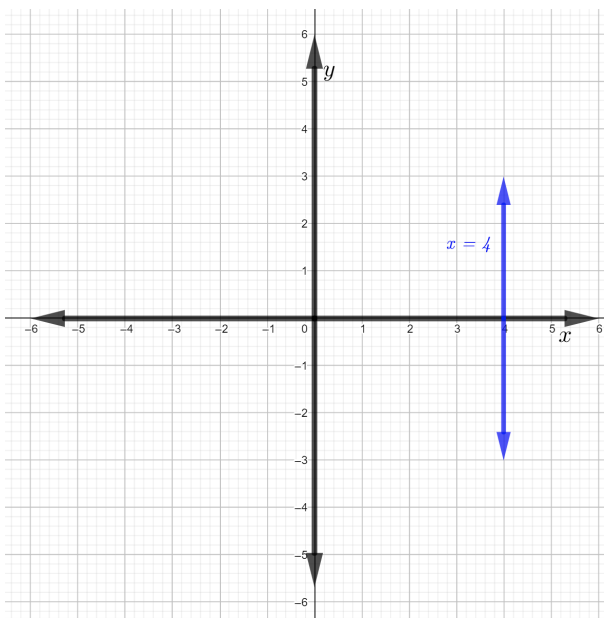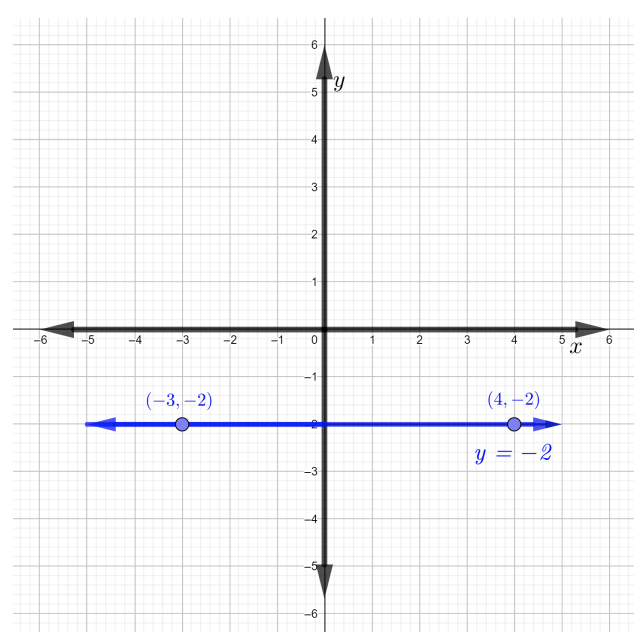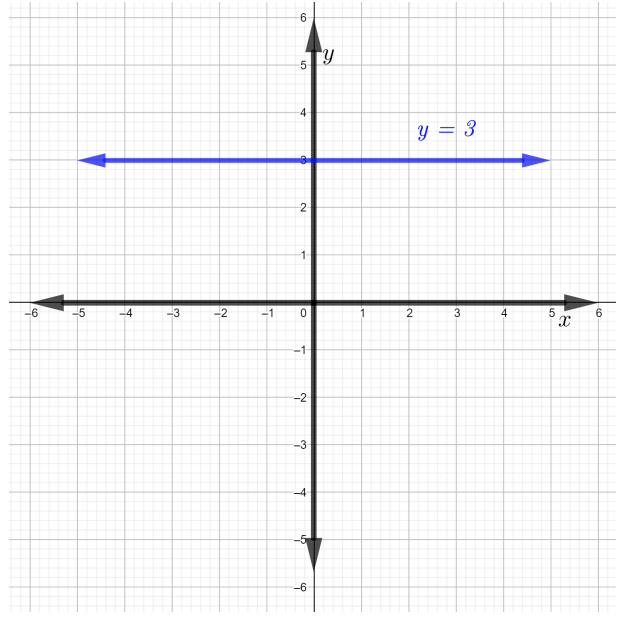7.4: Ecuaciones de Líneas Verticales y Horizontales
- Page ID
- 112462
La ecuación de una línea vertical es de la forma\(x = c\), donde\(c\) está cualquier número real. La línea vertical siempre cruzará el\(x\) eje −axis en el punto\((c, 0)\). La pendiente de una línea vertical es indefinida.
Encuentra la pendiente de la línea\(x = 4\) y grafica la línea.
Solución
\(x = 4\)es la gráfica de una línea vertical como se muestra en la siguiente figura.

Para encontrar la pendiente de la línea,\(x = 4\) elija dos puntos distintos en la línea. Que los puntos sean\((4, −1)\) y\((4, 3)\). Usando la pendiente de una fórmula de línea,
\(\begin{array} &&m = \dfrac{y_2 − y_1}{x_2 − x_1} &\text{The slope of a line formula} \\ &= \dfrac{3 − (−1)}{4 − 4} &\text{Substitute values} \\ &= \dfrac{4}{0} &\text{Simplify} \end{array}\)
Ahora bien, si\(4\) se divide por\(0\), esto equivale a hacer la pregunta”, ¿qué número por cero da\(4\)?” la respuesta es, no existe tal número. La división por cero no está definida, y la pendiente de la línea vertical\(x = 4\) es indefinida.
La ecuación de una línea horizontal es de la forma\(y = k\), donde\(k\) está cualquier número real. La línea horizontal siempre cruzará el\(y\) eje −axis en el punto\((0, k)\). La pendiente de una línea horizontal es Cero.
Encuentra la pendiente de la línea que pasa por los puntos\((−3, −2)\) y\((4, −2)\). Trazar los puntos y graficar la línea que pasa a través de ellos.
Solución
Utilice la pendiente de la fórmula de línea. Por lo tanto,
\(\begin{array} &&m = \dfrac{y_2 − y_1}{x_2 − x_1} &\text{The slope of a line formula} \\ &= \dfrac{(−2) − (−2)}{4 − (−3)} &\text{Substitute values} \\ &= \dfrac{0}{7} &\text{Simplify} \\ &= 0 &\text{\(0\)dividido por cualquier número distinto de cero es igual a cero}\ end {array}\)
Por lo tanto, la línea que pasa por los dos puntos dados es una línea horizontal, con pendiente igual a cero, como se muestra en la siguiente figura.

Grafica la línea\(y − 3 = 0\) y encuentra su pendiente.
Solución
La línea se\(y − 3 = 0\) puede escribir como\(y = 3\) (agregar\(3\) a ambos lados de la ecuación). La línea\(y = 3\) es una línea horizontal, como se muestra en la siguiente figura.

Ahora, para encontrar la pendiente, elija dos puntos distintos en la línea\(y = 3\). Considerar puntos\((0, 3)\) y\((3, 3)\). Por lo tanto,
\(\begin{array} &&m = \dfrac{y_2 − y_1}{x_2 − x_1} &\text{The slope of a line formula} \\ &= \dfrac{3-3}{3-0} &\text{Substitute values} \\ &= \dfrac{0}{2} &\text{Simplify} \\ &= 0 &\text{\(0\)dividido por cualquier número distinto de cero es igual a cero}\ end {array}\)
Por lo tanto, la pendiente de la línea dada es\(m = 0.\)
Encuentra la pendiente de cada línea.
- \(x = −\dfrac{1}{2}\)
- \(y − 1 = 0\)
- \(x + 7 = 10\)
- \(y + 2 = −9\)
- Encuentra la pendiente de la línea que pasa por los puntos\((−4, 1)\) y\((2, 1)\). Trazar los puntos y graficar la línea que pasa a través de ellos.
- Encuentra la pendiente de la línea que pasa por los puntos\((−3, 5)\) y\((−3, −7)\). Trazar los puntos y graficar la línea que pasa a través de ellos.


